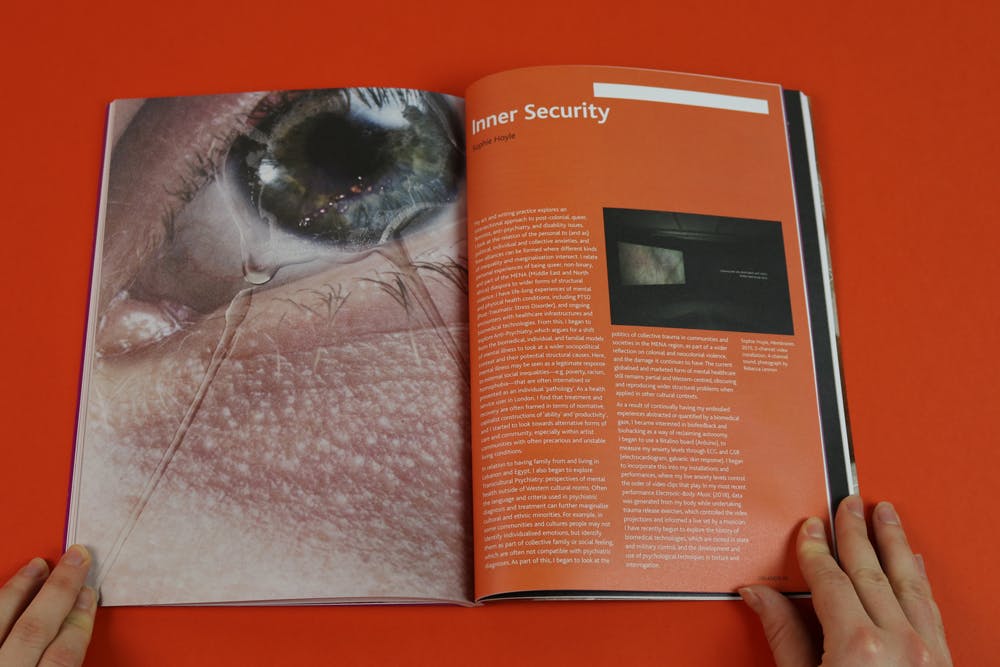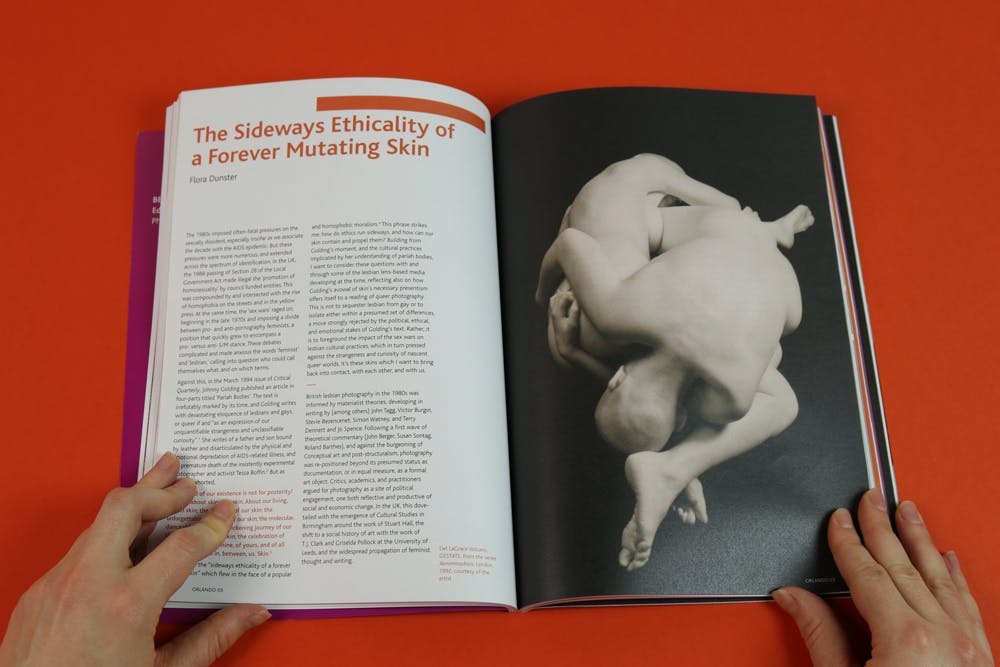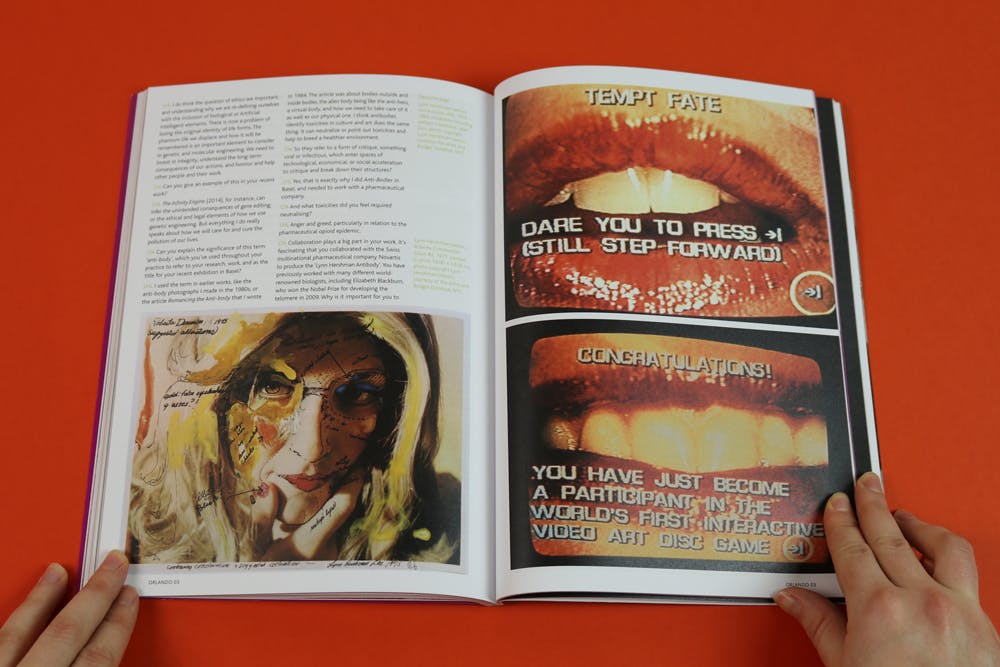Compulsory heterosexuality and a slimey octopus
Previous issues of Orlando magazine have explored ideas of memory and discourse, but with its image of a deliciously slippery octopus emblazoned across the cover, this third issue of the arts title is rooted in something more corporeal. Themed ‘Beyond the Body’, editor Philomena Epps wanted to make something that “considered what it both physically and psychically feels like to be a body in this current political moment, and something which could also offer a sense of release and escape”.
The lens is feminist, with the influence of queer theory felt throughout the pages, but where many feminist magazines out there can feel well-meaning, but ultimately a bit boring, Orlando is doing something a little offbeat. The opening essay, for example, looks sideways at the British national mood, via a detailed analysis of Amy Bell’s 2018 dance performance ‘The Forecast’. Another examines the way class has been written out of the narrative around the artist Jo Spence’s practise. Instead, she’s been neutralised as a “woman representing her own body”. Spence is pictured holding a sign that reads “If I don’t need to please my parents any more, why the fuck should I worry about pleasing you middle class bastards?”
The best pieces in the issue sneak up with an insight that frees you, however briefly, from habits of thought so entrenched you hadn’t questioned them. Our favourite is an essay by Ari Potter which reframes marriage as the only socially accepted way to confess to loneliness in an individualistic society. To want a partner is ‘normal’; not having one provokes ‘normal pain’. But in a society where we are all “consumed with appearing whole, complete, fulfilled”, relying deeply on friends — “caring beyond the bonds of blood and sex” — is stigmatised. So we retain the idea of marriage as a contract, “because we lack faith in our capacity to care without codifying it”.
Orlando 03 is a heavy, sticky read — one that makes you feel pleased, but also a bit sick about being alive inside a body right now. Touching on compulsory heterosexuality and the BBC’s Shipping Forecast, Philomena unpicked the new issue.
Why did you want to look at the body, and why now?
Throughout art or literary history, the use of the body as a raw material has been central to questioning facets of identity in contemporary culture, particularly the intersection of gender, sexuality, race, dis/ability, illness, etc. In recent years, there has been a transformative shift surrounding expanded concepts of the body, and a greater understanding, recognition, and celebration of non-conforming bodies, genders, and identities. However, there has also been a political and societal pushback against these new freedoms: the threat of the Far Right, environmental collapse, state-sanctioned racism, the transphobia rampant in mainstream feminism, #MeToo. Bodies are systemically punished, erased, abused daily in our society.
One of my favourite nuggets in the issue is the theory that the resurgence in people listening to the BBC’s Shipping Forecast is about national identity: we’re returning to the mentality of the geopolitically detached island state. Was looking at the political and national body, as well as the physical one, something you wanted to do with this issue?
Gabriella Beckhurst writes in their opening essay, “Weather forecasts offer a false sense of order — comfort even — by giving shape to the near future. Hundreds of thousands tune in to the Shipping Forecast despite having no practical reason for doing so. Many testify to the soporific effect of the 0048 broadcast as a cure for insomnia, and it has been noted that its continued popularity might be linked to our resurgent collective national identity as a geopolitically detached island-state.” I was definitely interested in the expanded and various notions of bodies and embodiment: individual bodies, collective bodies, political bodies, national bodies, even bodies of artistic work, and how these might intersect. When does a singular insomniac body listening to the shipping forecast become part of a group of bodies or forge a collective identity? When does the body become the body politic? How can our bodies mirror or seek to rupture our current moment?
Our favourite piece in the issue is about the marriage contract. The importance of marriage in society is reframed as a way of making the feeling of loneliness permissible in an individualistic society. Can you explain that idea?
In ‘The Marriage Contract’, Ari Potter wanted to explore the concept of the body as a possession, and how marriage is an extension of that notion, due to the history of women being treated as chattel. In the piece, the notion of marriage and partnership as another form of possession or investment becomes intrinsically linked to capitalism. The essay also exposes how the convention of marriage has “permitted us to entrench a certain level of accepted selfishness. The acceptability of desire for marriage allows people to confess to loneliness in an individualistic world where much of the narrative is dedicated to needing no one… Needing people doesn’t need to be restricted to setting up your own colony. Sex and romance could be separated from sharing material wealth altogether. Recognising the legitimacy of caring beyond the bonds of blood and sex would promote kindness and equality to strangers. We could build communities structured away from the restrictive, defined mini-businesses that is family as we know it today.”
We love the Dream Girls series by Deborah Bright featured in the issue. In it, stills from old Hollywood films are pasted over with images of the artist, who intrudes to act alongside the leading ladies. Why did you choose to include that series?
Deborah Bright’s work is included in Flora Dunster’s essay ‘The Sideways Ethicality of a Forever Mutating Skin,’ which considers the impact of the 1980s ‘Sex Wars’ on lesbian cultural practices, using examples of photography and film that considered the emotional, sexual, and spatial configurations of the “lesbian/dyke/queer body”. In Bright’s ‘Dream Girls’ (1989-90), she deploys the tactics of pastiche and appropriation, purchasing stills from old Hollywood films, pasting images of herself on top, and re-photographing the result to create a new image. These new images propose the possibility of alternative lesbian pasts and presents. As Dunster writes, “In tall leather boots and a leather jacket, she gazes coyly at Katherine Hepburn. In another still, she positions herself across the table from Glenda Jackson, interrupting dinner to give Jackson something more interesting to look at, and edging her male dinner companion out of the visual loop.”
Compulsory heterosexuality is something that comes up across the issue. What does that term mean, and why was it something you wanted to question?
In her 1980 essay ‘Compulsory Heterosexuality and Lesbian Existence’, the American essayist and poet Adrienne Rich explored how heterosexuality is assumed and enforced by a heteronormative society, which results in women feeling obligated to adhere to heterosexual ‘norms’ (regardless of their actual preferences) to avoid appearing deviant or abhorrent. Both Rosie Haward and Rebecca Jagoe cite the scholar Sara Ahmed’s book Queer Phenomenology: Orientations, Objects, Others (2006) in their contributions to the magazine, with Jagoe quoting from this particular passage by Ahmed: “Compulsory heterosexuality shapes what bodies can do. Bodies take the shape of norms that are repeated over time and with force … Compulsory heterosexuality diminishes the very capacity of bodies to reach what is off the straight line … The queer child can only, in this wish for the straight line, be read as the source of injury: a sign of the failure to repay the debt of life by becoming straight.”
The body, as the essay about artist Jo Spence points out, is a site of political conflict. How can a body be a site of political conflict?
In her essay on the work of Jo Spence, Frances Hatherley considered how the issue of class — stated by Spence to be one of her central concerns –had been systematically erased and written out of narratives from the discourse surrounding her practice. “Yet for Spence,” writes Hatherley, “the female body was always a site of political conflict, and always approached with an awareness of how bodies come to inhabit the intersecting oppressions experienced by women.” The essay goes on to explore more generally how the fat, female, working class body has been condemned by society: “the image of the working-class in British popular imagination is that of a demonised body, on which is written a brash, distasteful, lazy ignorance … women’s visible rejection of the discipline of bodily regulation is taken as evidence of a loss of control over the self and its physical boundaries. The fat, female, working class body is therefore doubly despised and ridiculed.” Spence’s work offered space for and reclaimed the bodies and identities treated as unsuitable for arts spaces, encouraging women to reject middle-class defined respectable feminine behaviours, and to rebel against the way their identities have been constructed for them.
In the midst of an upswing in mainstream feminist content, what motivates you keep publishing a feminist magazine? Obviously there are great reasons to keep going. But we wanted to ask you, what are yours?
Although the magazine is evidently influenced by feminism and queer theory, this perspective is used to question the negative effect of any rigid or stigmatising politics. I often find the magazine is pigeonholed as niche because it has a feminist core, rather than understood that feminism is part of a wider politics that underscores an engagement with a multitude of issues and topics. This feeds into the creation of Orlando as an expansive and fluid space in which individuals can express themselves without feeling pressured to conform to a homogenous style or mode of writing. Since publishing the first issue in 2014, I have found that the creative urgency of publishing an independent magazine that is empathetic, liberated, and critically engaged has only increased, amid the rising vicissitudes of violence, oppression, and inequality in society. It sits outside of the mainstream media, resists the tropes of fast journalism, or the potential alienation caused by stuffy academic journals, and has no corporate stakeholders and is free from commercial interest. These choices are all feminist.
- Lead image credit: Untitled, from Dream Girls series, 1989-90. Silver gelatin photograph, 11 x 14 in. Courtesy of the artist.









